
German postcard by Ross Verlag, no. 649/1. Photo: Henny Porten-Film. Henny Porten in the classic Kammerspiel film Hintertreppe/Backstairs (Leopold Jessner, 1921).
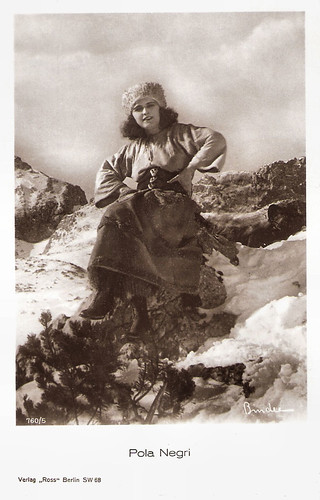
German postcard by Ross Verlag, Berlin, no. 760/5. Photo: Alex Binder. Pola Negri in Die Bergkatze/Wildcat (Ernst Lubitsch, 1921).
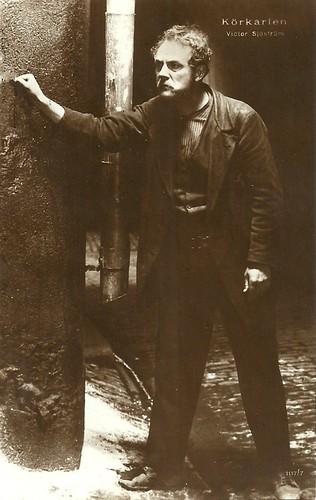
Swedish postcard by Ed. Nordisk Konst, Stockholm, no. 1117/7. Photo: Svensk Filmindustri. Victor Sjöström in Körkarlen/The Phantom Carriage (Victor Sjöström, 1920). As he is the last one to die on New Year's Eve, the drunkard David Holm (Sjöström) is forced to take over the phantom carriage for a full year, collecting the souls of the dead.
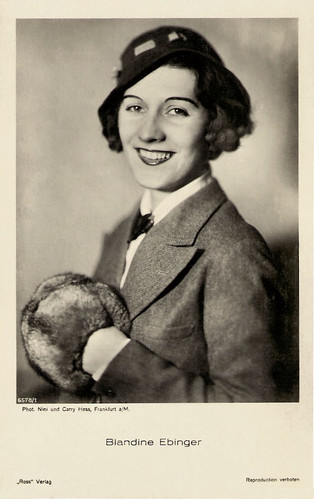
German postcard by Ross Verlag, no. 6578/1, 1931-1932. Photo: Nini and Carry Hess, Frankfurt a/M.
German cabaret singer and actress Blandine Ebinger (1899-1993) appeared in Die Ratten/The Rats (Hans Kobe, 1921). Author Erich Kästner described her as “This lisping, scrawny person with the big, severe eyes is a master of the tragic-grotesque.” Her cinema career continued for seventy (70!) years. Her more than 90 film roles were once bigger, once smaller, but all her characters distinguished through her impressive acting.
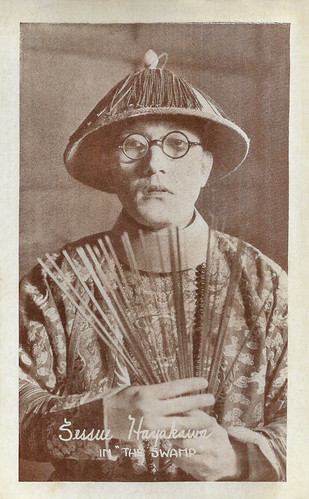
American arcade postcard. Sessue Hayakawa in The Swamp (Colin Campbell, 1921).
Sessue Hayakawa (1889–1973) was a Japanese actor who starred in more than 80 American, Japanese, French, German, and British films. He was the first Asian actor to find stardom first in Hollywood and later in Europe. His 'broodingly handsome' good looks and typecasting as a sinister villain with sexual dominance made him a heartthrob among female audiences in the 1910s and early 1920s.

German postcard by Ross Verlag, no. 799/2, 1925-1926. Photo: Phoebus Film.
In 1920, American silent film actor, comedian Roscoe ‘Fatty’ Arbuckle (1887-1933) signed a contract with Paramount Pictures for US$1 million. On 28 August 1921, his Crazy to Marry (James Cruze, 1921) premiered. But between November 1921 and April 1922, Arbuckle was the defendant in three widely publicised trials for the rape and manslaughter of actress Virginia Rappe. Following the trials, his films were banned and he was publicly ostracized.

German postcard by Ross Verlag, no. 830/1, 1925-1926. Photo: British-American Films A.G. Balag. Alla Nazimova in Camille (Ray C. Smallwood, 1921). Nazimova played the courtesan Marguerite opposite Rudolph Valentino as her idealistic young lover Armand. Camille is based on 'La Dame aux Camélias' (The Lady of the Camellias) by Alexandre Dumas, fils. The film was set in 1920s Paris, whereas the original version took place in Paris in the 1840s. It had lavish Art Deco sets and Rudolph Valentino later married the art director, Natacha Rambova.

German postcard by Ross Verlag, Berlin, no. 1174/3, 1927-1928. Georges Biscot, presented in Germany as 'Biscot Meyer', in L'orpheline/The orphan (Louis Feuillade, 1921).
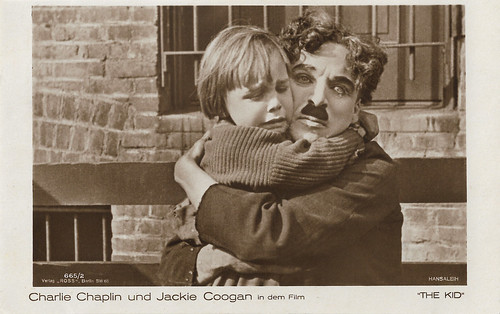
German postcard by Ross Verlag, no. 665/2. Photo: Hansaleih. Charlie Chaplin and Jackie Coogan in The Kid (Charles Chaplin, 1921).

Spanish collectors card by Chocolates Amatller, Barcelona, in the 'Artistas de cine' series, no. 11: Larry Semon. Image: Martinez Surroca.
Lawrence 'Larry' Semon (1889-1928) was an American actor, director, producer, and screenwriter during the silent film era. In his day, Semon was considered a major film comedian, but he is now remembered mainly for working with both Stan Laurel and Oliver Hardy before they started working together.

American postcard by Max B. Sheffer Card Co., Chicago (M.B.S.C.Co.), 1922. Photo: Paramount. Dorothy Dalton as Poll Patchouli in Fool's Paradise (Cecil B. DeMille, 1921).

American postcard by Max B. Sheffer Card Co., Chicago (M.B.S.C.Co.), 1922. Photo: Paramount. William S. Hart as Oak Miller in White Oak (Lambert Hillyer, 1921).

Italian postcard. Photo: Fert Film. Diomira Jacobini in L'isola della felicità/The Island of Happiness (Luciano Doria, 1921). Caption: Towards new happiness.
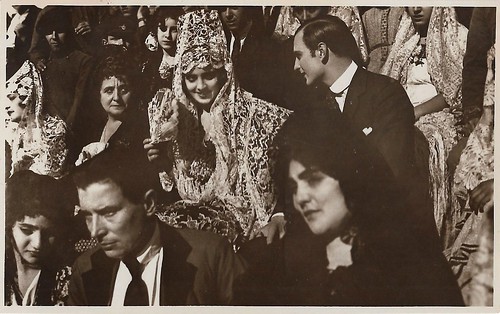
Italian postcard by Fotominio. Photo: G.B. Falci, Milano / Fert Film. Ida Carloni Talli, Maria Jacobini and Lido Manetti in Amore rosso/Red Love (Gennaro Righelli, 1921). Caption: During the corrida. Don Alvaro gets to know Juanita.

Italian postcard by G. Vettori, Bologna, no. 453. Photo: Renato Cartoni (who was also the cameraman). Vera Vergani and Nerio Bernardi in Il filo d'Arianna/Ariadne's thread (Mario Caserini, 1921).

Hungarian postcard. Photo: Korona Film Ica Lenkeffy and Emil Fenyö in A szerelem mindent legyöz/Love Conquers All (László Márkus, 1921). The film was scripted by Ladislaus Vajda and based on a novel by Ethel M. Dell. The subitle of the film is Minden poklokon keresztül/Through All Hells.

Swedish postcard by Axel Eliassons Konstförlag, Stockholm, no. 291. Photo: Skandia-Film. Pauline Brunius and Paul Seelig in the Swedish silent drama En vildfågel/Give Me My Son (John W. Brunius, 1921). Adapted from the play 'Skeppsbrott' (Shipwreck) by Samuel A. Duse. The title means literally 'The Wild Bird'. On 3 October 1921, En vildfågel premiered simultaneously in five cinemas in five different Swedish cities.

Czech postcard. Armando Brasini's gigantic set for the Italian silent epic Teodora /Theodora (Leopoldo Carluccio, 1921).

Swedish postcard by Officin. A.-B. Svea Film Imp., no. 17. Photo: Svea Film. Anna Q. Nilsson in Värmlänningarna (Erik Petschler, 1921), adapted from the play by Fredrik August Dahlgren.

Hungarian postcard by MFSI, no 24. Photo: May. Ila Lóth in Lengyelvér/Polish Blood (Béla Balogh, 1921).

French postcard by M. Le Deley, Paris. Photo: still from Les Trois Mousquetaires/The Three Musketeers (Henri Diamant Berger, 1921), based on the famous novel by Alexandre Dumas père, and produced by Pathé Consortium Cinéma. The Gascon D'Artagnan was played by Aimé Simon-Girard. The three musketeers were impersonated by Henri Rollan as Athos, Charles Martinelli as Porthos, and Pierre de Guingand as Aramis.
And please check out our posts on L'empereur des pauvres/The emperor of the poor (René Leprince, 1921), Favilla/Love's Labour Won (Ivo Illuminati, 1921), Il figlio di Madame Sans-Gêne/The Son of Madame Sans-Gêne (Baldassarre Negroni, 1921), La nave/The Ship (Gabriellino D'Annunzio, Mario Roncoroni, 1921), Il ponte dei sospiri/The Bridge of Sighs (Domenico Gaido, 1921), La preda/The prey (Guglielmo Zorzi, 1921), and La statua di carne/The statue of flesh (Mario Almirante, 1921).

German postcard by Ross Verlag, no. 799/2, 1925-1926. Photo: Phoebus Film.
In 1920, American silent film actor, comedian Roscoe ‘Fatty’ Arbuckle (1887-1933) signed a contract with Paramount Pictures for US$1 million. On 28 August 1921, his Crazy to Marry (James Cruze, 1921) premiered. But between November 1921 and April 1922, Arbuckle was the defendant in three widely publicised trials for the rape and manslaughter of actress Virginia Rappe. Following the trials, his films were banned and he was publicly ostracized.

German postcard by Ross Verlag, no. 830/1, 1925-1926. Photo: British-American Films A.G. Balag. Alla Nazimova in Camille (Ray C. Smallwood, 1921). Nazimova played the courtesan Marguerite opposite Rudolph Valentino as her idealistic young lover Armand. Camille is based on 'La Dame aux Camélias' (The Lady of the Camellias) by Alexandre Dumas, fils. The film was set in 1920s Paris, whereas the original version took place in Paris in the 1840s. It had lavish Art Deco sets and Rudolph Valentino later married the art director, Natacha Rambova.

German postcard by Ross Verlag, Berlin, no. 1174/3, 1927-1928. Georges Biscot, presented in Germany as 'Biscot Meyer', in L'orpheline/The orphan (Louis Feuillade, 1921).

German postcard by Ross Verlag, no. 665/2. Photo: Hansaleih. Charlie Chaplin and Jackie Coogan in The Kid (Charles Chaplin, 1921).

Spanish collectors card by Chocolates Amatller, Barcelona, in the 'Artistas de cine' series, no. 11: Larry Semon. Image: Martinez Surroca.
Lawrence 'Larry' Semon (1889-1928) was an American actor, director, producer, and screenwriter during the silent film era. In his day, Semon was considered a major film comedian, but he is now remembered mainly for working with both Stan Laurel and Oliver Hardy before they started working together.
Not in Bologna, but also from 1921

American postcard by Max B. Sheffer Card Co., Chicago (M.B.S.C.Co.), 1922. Photo: Paramount. Dorothy Dalton as Poll Patchouli in Fool's Paradise (Cecil B. DeMille, 1921).

American postcard by Max B. Sheffer Card Co., Chicago (M.B.S.C.Co.), 1922. Photo: Paramount. William S. Hart as Oak Miller in White Oak (Lambert Hillyer, 1921).

Italian postcard. Photo: Fert Film. Diomira Jacobini in L'isola della felicità/The Island of Happiness (Luciano Doria, 1921). Caption: Towards new happiness.

Italian postcard by Fotominio. Photo: G.B. Falci, Milano / Fert Film. Ida Carloni Talli, Maria Jacobini and Lido Manetti in Amore rosso/Red Love (Gennaro Righelli, 1921). Caption: During the corrida. Don Alvaro gets to know Juanita.

Italian postcard by G. Vettori, Bologna, no. 453. Photo: Renato Cartoni (who was also the cameraman). Vera Vergani and Nerio Bernardi in Il filo d'Arianna/Ariadne's thread (Mario Caserini, 1921).

Hungarian postcard. Photo: Korona Film Ica Lenkeffy and Emil Fenyö in A szerelem mindent legyöz/Love Conquers All (László Márkus, 1921). The film was scripted by Ladislaus Vajda and based on a novel by Ethel M. Dell. The subitle of the film is Minden poklokon keresztül/Through All Hells.

Swedish postcard by Axel Eliassons Konstförlag, Stockholm, no. 291. Photo: Skandia-Film. Pauline Brunius and Paul Seelig in the Swedish silent drama En vildfågel/Give Me My Son (John W. Brunius, 1921). Adapted from the play 'Skeppsbrott' (Shipwreck) by Samuel A. Duse. The title means literally 'The Wild Bird'. On 3 October 1921, En vildfågel premiered simultaneously in five cinemas in five different Swedish cities.

Czech postcard. Armando Brasini's gigantic set for the Italian silent epic Teodora /Theodora (Leopoldo Carluccio, 1921).

Swedish postcard by Officin. A.-B. Svea Film Imp., no. 17. Photo: Svea Film. Anna Q. Nilsson in Värmlänningarna (Erik Petschler, 1921), adapted from the play by Fredrik August Dahlgren.

Hungarian postcard by MFSI, no 24. Photo: May. Ila Lóth in Lengyelvér/Polish Blood (Béla Balogh, 1921).

French postcard by M. Le Deley, Paris. Photo: still from Les Trois Mousquetaires/The Three Musketeers (Henri Diamant Berger, 1921), based on the famous novel by Alexandre Dumas père, and produced by Pathé Consortium Cinéma. The Gascon D'Artagnan was played by Aimé Simon-Girard. The three musketeers were impersonated by Henri Rollan as Athos, Charles Martinelli as Porthos, and Pierre de Guingand as Aramis.
And please check out our posts on L'empereur des pauvres/The emperor of the poor (René Leprince, 1921), Favilla/Love's Labour Won (Ivo Illuminati, 1921), Il figlio di Madame Sans-Gêne/The Son of Madame Sans-Gêne (Baldassarre Negroni, 1921), La nave/The Ship (Gabriellino D'Annunzio, Mario Roncoroni, 1921), Il ponte dei sospiri/The Bridge of Sighs (Domenico Gaido, 1921), La preda/The prey (Guglielmo Zorzi, 1921), and La statua di carne/The statue of flesh (Mario Almirante, 1921).
No comments:
Post a Comment